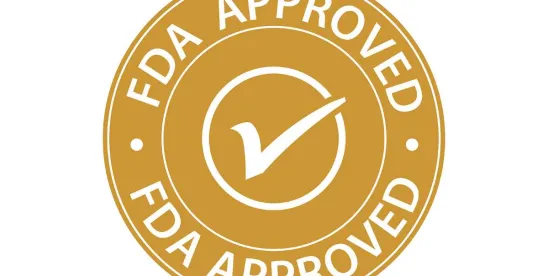On August 1, 2024, the U.S. Food and Drug Administration (FDA) Office of Prescription Drug Promotion (OPDP) issued an untitled letter to Mirati Therapeutics Inc., a Bristol Myers Squibb Co. (Mirati), relating to promotional communications made on its Healthcare Provider Branded Website for its accelerated approval drug, KRAZATI™ (adagrasib) tablets, for oral use (Krazati).[1] Krazati is indicated for the treatment of adult patients with KRAS G12C-mutated locally advanced or metastatic non-small cell lung cancer (NSCLC), as determined by an FDA approved test, who have received at least one prior systemic therapy.
Promotional Claims at Issue
In this letter, FDA’s concerns primarily centered around the presentation of data from the KRYSTAL-1 clinical trial, the foundation of Krazati’s approval. The various claims at issue appeared on a webpage titled “KRYSTAL-1 EFFICACY,” which prompted users to “Scroll to see the efficacy of Krazati” (emphasis added) and provided a navigational bar with the following headings: “ORR”; “DCR” (Disease Control Rate); “Intracranial ORR”; “OS” (Overall Survival); “PFS” (Progression-free Survival); and “DOR.”
In concluding that the website overstated the efficacy of Krazati, and thereby misbranded the drug, FDA focused on the following claims:
- “DCR IN PATIENTS TAKING KRAZATI: 80% (n=112; 95% CI: 70.8-86.5)” and “Depth of response: 80% of patients experienced tumor shrinkage of any magnitude,” presented in conjunction with a waterfall plot with data purporting to present patients with stable disease (SD), partial response (PR), or complete response (CR);
- “MEDIAN OS IN PATIENTS TAKING KRAZATI: 14.1 MONTHS” and “MEDIAN PFS IN PATIENTS IN PATIENTS TAKING KRAZATI: 6.9 MONTHS,” presented in conjunction with two graphs presenting “Survival Probability” and “PFS Probability,” over time (months), respectively;
- A graph titled “DESCRIPTIVE ANALYSIS MEDIAN DOR IN PATIENTS TAKING KRAZATI: 12.5 MONTHS”; and
- “33% INTRACRANIAL ORR IN PATIENTS WITH STABLE, ADEQUATELY TREATED BRAIN METASTASES” and “INTRACRANIAL DCR IN PATIENTS WITH BRAIN METASTASES: 85% (n=33; 95% CI: 68-95).”
FDA concluded that the representations and presentation of data for DCR, OS, and PFS were misleading because the KRYSTAL-1 trial was incapable of producing these results. In so doing, FDA repeatedly underscored that, as a single-arm trial, KRYSTAL-1 was not designed to produce results relating to “time-to-event efficacy endpoints” such as SD, OS, and PFS. FDA explained that such endpoints are “generally uninterpretable” from single-arm trials “because it is not possible to determine if the observed effect . . . is attributable to the drug or the natural history of the disease.” Instead, such endpoints “require[] randomized controlled trials because a comparator arm is necessary to assess whether the effect seen on the endpoint being studied is attributable to the drug or some other factor.”
FDA similarly explained that KRYSTAL-1 was incapable of producing results relating to Intracranial ORR and Intracranial DCR. Although Mirati cited two studies in support of these claims, FDA determined that such conclusions regarding brain metastases could not be supported by this post-hoc analysis. FDA explained that in order to make such claims, the trial would have had to collect data regarding how each target lesion was previously treated, but such information was not collected in KRYSTAL-1. Instead, according to FDA, “[i]t is known only that the majority of patients (27 out of the 33 evaluable patients) included in this post-hoc subgroup analysis were previously treated with radiation therapy for brain metastases,” and, thus, these results could have been attributable to radiation therapy instead of Krazati.
Regarding median DOR, FDA further concluded that this claim misleadingly overstated the efficacy of Krazati; however, unlike the aforementioned claims, this was not because the trial was incapable of producing such results. Rather, FDA’s main concern appeared to be with Mirati’s citation to pooled DOR “data on file.” FDA highlighted the analytical problems presented by pooling data and noted that “differences among studies and study populations can affect the validity and interpretability of pooled analyses.” The agency further stated that it was “not able to verify the presented results,” “is not aware of data that can support” the median DOR claim, but suggested that Mirati submit such data to FDA for review.
Ultimately, FDA’s core thesis for alleging that the website misbranded Krazati centered on the inherent limitations of the KRYSTAL-1 trial and presentation of data that went beyond what the trial was capable of producing. To be sure, FDA recognized the inclusion of several disclaimers relating to the OS/PFS[2] and Intracranial ORR[3] claims. However, FDA determined that such disclaimers did not correct and/or mitigate the misleading impression created by the presentation of such data.[4]
Takeaways
This untitled letter serves as a cautionary tale to sponsors of accelerated approval drugs. While it is not uncommon for OPDP to evaluate whether promotional claims align with product labeling, this letter suggests that FDA may take a more stringent approach to regulating CFL claims for drugs approved under expedited pathways. The devil is always in the details, but here, FDA appears to be signaling that even some content is a bridge too far, given the context.
In addition to traditional approval pathways (e.g., NDA approval under 21 U.S.C. § 355), the FDCA provides various options for expedited approval of drugs for “serious or life-threatening disease[s] or condition[s].”[5] Among these options, accelerated approval may be available for certain drugs based on a so-called “surrogate or an intermediate clinical endpoint.”[6] This means that instead of demonstrating the overall “clinical benefit” of a drug, FDA approval may be based on an endpoint that “is considered reasonably likely to predict the clinical benefit of the drug.”[7] In this case, FDA’s approval for Krazati was based on a showing of “objective response rate (ORR) and duration of response (DOR)” in the KRYSTAL-1 trial.
However, after receiving this expedited approved, the sponsor is not off the hook – they must conduct confirmatory trials to verify clinical benefit or else “[a]pproval of [the] drug may be withdrawn or the labeled indication of the drug changed if trials fail to verify clinical benefit or do not demonstrate sufficient clinical benefit to justify the risks associated with the drug.”[8] Indeed, according to FDA’s Ongoing Cancer Accelerated Approvals database, Krazati is required to complete “a randomized comparative clinical trial . . . to obtain OS, PFS, ORR, and DOR” data,[9] and, according to the untitled letter, such study is ongoing but not yet completed.[10]
Given this context, it is unsurprising that FDA would adopt a more critical stance towards efficacy claims for such drugs. However, based on the authors’ review of recent OPDP Untitled Letters,[11] advertising for accelerated approval drugs does not appear to be a priority for the agency. So, what stands out here?
FDA noted two motivations directly in the text of the letter: (1) the agency received multiple complaints for the website through FDA’s Bad Ad Program; and (2) metastatic NSCLC presents a serious public health concern because it is an incurable condition with a 5-year survival rate of less than 10%, and “lung cancer is by far the leading cause of cancer death in the United States.” However, these concerns still do not answer what prompted so many complaints in the first place.
Alternatively, another explanation may be based on a perceived noncompliance with not only the CFL Guidance[12], but also FDA’s Clinical Trial Endpoints for the Approval of Cancer Drugs and Biologics Guidance.[13] In particular, the CFL Guidance makes clear that evidence used to support CFL promotional communications must be “scientifically appropriate and statistically sound.”[14] Adding to this, in the Clinical Trial Endpoints Guidance, FDA plainly states that, while single-arm trials are capable of providing an accurate assessment of some endpoints (such as ORR), “[s]table disease should not be a component of ORR” and “[s]ingle-arm trials do not adequately characterize time-to-event endpoints such as overall survival . . . or PFS” and a randomized study is instead necessary to evaluate such endpoints.[15] Accordingly, FDA may have felt that Mirati’s claims about the KRYSTAL-1 trial went a step too far, and directly ran afoul of FDA’s parameters regarding what results are acceptable to draw from a single-arm trial.
All in all, this letter highlights the continued importance of FDA’s CFL Guidance. As noted in prior blog posts,[16] this is an ongoing trend from OPDP, and companies should continue to keep this in mind when drafting promotional communications. Furthermore, this letter highlights a unique application of the CFL Guidance to accelerated approval drugs. Given the qualified nature of accelerated approval, it is paramount that sponsors consider whether FDA has spoken on what conclusions may be drawn from clinical trials involving a particular disease state Indeed, the agency often issues disease-specific guidance. In light of this untitled letter, these guidances may prove to be important not only for clinical trial design, but also for predicting how FDA may evaluate post-approval claims and the underlying evidence to support CFL communications.
FOOTNOTES
[1] Promotional Material available here: Promotional Material Krazati (fda.gov).
[2] “[S]ingle-arm trials do not adequately characterize time-to-event endpoints such as OS/PFS. Thus, these data from KRYSTAL-1 cannot be interpreted as having OS/PFS benefit.” Krazati Letter, at 4.
[3] “INTRACRANIAL ORR AND DCR CANNOT BE ATTRIBUTED TO KRAZATI ALONE GIVEN BRAIN METASTASES WERE PREVIOUSLY TREATED, SOME WITH RECENT PRIOR RADIATION. THESE RESULTS SHOULD BE INTERPRETED WITH CAUTION.” Id. at 5.
[4] In particular, with regards to OS/PFS, FDA highlighted that this disclaimer was insufficient because KRYSTAL-1 “is not capable of supporting such representations or suggestions.” Similarly, regarding Intracranial ORR, FDA noted that the disclaimer also missed the mark because “the statements suggest that intracranial ORR and DCR can be attributed, in part, to an effect of Krazati when these data cannot be interpreted at all as an effect of Krazati.” (emphasis in original).
[5] See 21 U.S.C. § 356.
[6] See Accelerated Approval | FDA.
[7] See id.
[8] Id.
[9] See Ongoing | Cancer Accelerated Approvals | FDA.
[10] Krazati Letter at 2, n. 4.
[11] See generally Untitled Letters | FDA.
[12] “Medical Product Communications That Are Consistent With the FDA-Required Labeling, Questions and Answers” (CFL Guidance) available here: *Medical Product Communications That Are Consistent With the FDA-Required Labeling — Questions and Answers Guidance for Industry.
[13] Clinical Trial Endpoints for the Approval of Cancer Drugs and Biologics Guidance available here: *Clinical Trial Endpoints for the Approval of Cancer Drugs and Biologics (fda.gov).
[14] See CFL Guidance, at 11-13.
[15] See Clinical Trial Endpoints Guidance, at 4, 9, 13.




 />i
/>i

